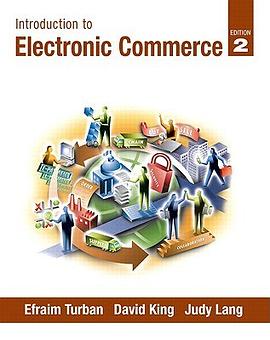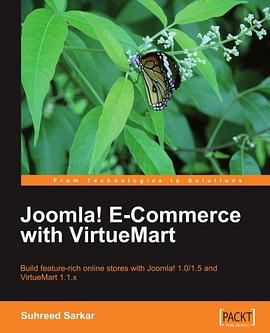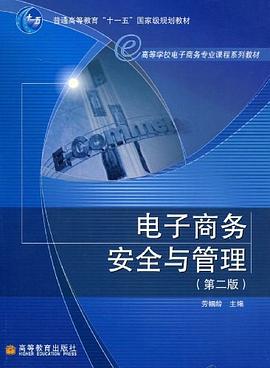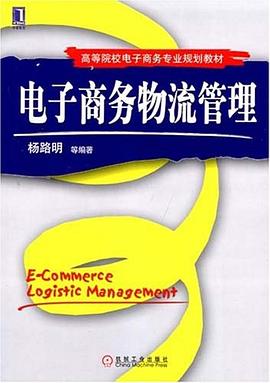

具体描述
《电子商务(英文精编版)(第8版)》是一本均衡讲述电子商务中商务问题和技术问题的教科书,既不是避开技术谈管理,也不是通篇陷入技术细节之中,达到了技术与管理、管理与实务的有机结合。全书分为四篇,即概述篇、业务战略篇、技术篇和整合篇。较之旧版,新版力求反映出电子商务领域中的最新变化以及企业和社会如何响应这些变化。新增的内容包括:品牌作用和在线销售的品牌产品,音乐和影视产品在线销售的新进展,移动商务中的融合作用,文字广告的新形式,移动用户和Web,社会网络站点,小额贷款方面的进展,在线客户关系管理软件等。
《电子商务(英文精编版)(第8版)》定位明确、体例新颖、结构合理、内容全面、评议精炼、叙述清晰、适合作为高等院校相关专业的电子商务课程教材,也可供企业经营管理者和从事电子商务的专业人士参考。
强力推荐:E-Business 英文原版火热发售
作者简介
Gary P.Schneider,目前是美国奎尼皮亚克大学会计系的William S.Perlroth教授,曾先后任教于圣迭戈大学、田纳西大学、赛维尔大学,讲授电子商务、数据库设计、供应链管理和管理会计等课程,多次获得优秀教学奖。迄今为止,他在会计、信息系统、管理学方面已经出版了50多部著作,并在《lnterfaces》、《IS Audit&Conlrol Joumal》、《Joumal oflnformation Systems》等许多权威刊物上发表了。90余篇研究论文。他在美国会计协会非常活跃,现任《Accounling lnformationSystems and Technology Reporter》的编辑,并同时兼任多个权威期刊的编委。他在开始学术生涯之前,在俄亥俄州作为CPA(注册会计师)工作了14年。
目录信息
Part1:Introduction
Chapter 1 Introduction to Electronic Commerce
Electronic Commerce:The Second Wave
Electronic Commerce and Electronic Business
Categories of Electronic Commerce
The Development and Growth of Electronic Commerce
The Dot-Com Boom.Bust.and Rebirth
The Second Wave of Electronic Commerce
Business Models.Revenue Models.and Business Processes
Focus on Specific Business Processes
Role of Merchandising
product/Process Suitability to Electronic Commerce
Advantages of Electronic Commerce
Disadvantages of Electronic Commerce
Economic Forces and E1ectroniO Commerce
Transaction Costs
Markets and Hierarchies
Using Electronic Commerce to Reduce Transaction Costs
Network Economic Structures
Network Effects
Using Electronic Commerce to Create Network Effects
Identifying Electronic commerce 0pportunities
Strategic Business Unit Value Chains
Industry Value Chains
SWOT Analysis:Evaluating Business Unit opportunities
International Nature of Electronic Commerce
Trust Issues on the Web
Language Issues
Cultural Issues
Culture and Government
Infrastructure Issues
Summary
Key Terms
Review Questions
Exercises
Cases
For Further Study and Research
Chapter 2 Technology Infrastructure: The Internet and the World Wide Web
The Internet and the World Wide Web
Origins of the Internet
New Uses for the Internet
Commercial Use of the Internet
Growth of the Internet
Emergence 0f the W0rld Wide Web
Packet-Switched Networks
Routing Packets
Internet Protocols
TCP/IP
IP Addressing
Domain Names
Web Page Request and Delivery Protocols
Electronic Mail Protocols
Unsolicited Commercial E.Mail(UCE,Spam)
Markup Languages and the Web
Standard Generalized Markup Language
Hypertext Markup Language
Extensible Markup Language(XML)
HTML and XML Editors
Intranets and Extranets
Intranets
Extranets
Public and Private Networks
Virtual Private Network (VPN)
Internet Connection Options
Connectivity Overview
Voice-Grade Telephone Connections
Broadband Connections
Leased-Line Connections
Wireless Connections
Internet and the Semantic Web
Summary
Key Terms
Review Questions
Exercises
Cases
For Further Study and Research
Part 2:Business Strategies for Electronic Commerce
Chapter 3 Selling on the Web: Revenue Models and Building a Web Presence
Revenue Models
Web Catalog Revenue M0dels
Digital Content Revenue Models
Advertising-Supported Revenue Models
Advertising-Subscription Mixed Revenue Models
Fee-for-Transaction Revenue Models
Online Video
Fee-for-Service Revenue Models
Revenue Models in Transition
Subscription to Advertising-Supported Model
Advertising-Supported to Advertising-Subscription Mixed Model
Advertising-Supported to Fee-for-Services Model
Advertising-Supported to Subscription Model
Multiple Transitions
Revenue Strategy Issues
Channel Conflict and Cannibalization
Strategic Alliances and Channel Distribution Management
Mobile Commerce
Creating an Effective Web Presence
Identifying Web Presence Goals
Achieving Web Presence Goals
Web Site Usability
How the Web Is Different
Meeting the Needs of Web Site Visitors
Trust and Loyalty
Rating Electronic Commerce Web Sites
Usability Testing
Customer-Centric Web Site Design
Connecting with Customers
The Nature of Communication on the Web
Summary
Key Terms
Review Questions
Exercises
Cases
For Further Study and Research
Chapter 4 Marketing on the Web
Web Marketing Strategies
Product-Based Marketing Strategies
Customer-Based Marketing Strategies
Communicating with Different Market Segments
Trust, Complexity, and Media Choice
Market Segmentation
Market Segmentation on the Web
Offering Customers a Choice on the Web
Beyond Market Segmentation: Customer Behavior and Relationship Intensity
Segmentation Using Customer Behavior
Customer Relationship Intensity and Life-Cycle Segmentation
Acquisition, Conversion, and Retention of Customers
Customer Acquisition, Conversion, and Retention: The Funnel Model
Advertising on the Web
Banner Ads
Text Ads
Other Web Ad Formats
Site Sponsorships
Online Advertising Cost and Effectiveness
Effectiveness of Online Advertising
E-Mail Marketing
Permission Marketing
Combining Content and Advertising
Outsourcing E-Mail Processing
Technology-Enabled Customer Relationship Management
CRM as a Source of Value in the Marketspace
Creating and Maintaining Brands on the Web
Elements of Branding
Emotional Branding vs. Rational Branding
Brand Leveraging Strategies
Brand Consolidation Strategies
Costs of Branding
Affiliate Marketing Strategies
Viral Marketing Strategies
Search Engine Positioning and Domain Names
Search Engines and Web Directories
Paid Search Engine Inclusion and Placement
Web Site Naming Issues
Summary
Key Terms
Review Questions
Exercises
Cases
For Further Study and Research
Chapter 5 Business-to-Business Online Strategies
Purchasing, Logistics, and Support Activities
Purchasing Activities
Direct vs. Indirect Materials Purchasing
Logistics Activities
Support Activities
E-Government
Network Model of Economic Organization
Electronic Data Interchange
Early Business Information Interchange Efforts
Emergence of Broader EDI Standards
How EDI Works
Value-Added Networks
EDI Payments
EDI on the Internet
Open Architecture of the Internet
Supply Chain Management Using Internet Technologies
Value Creation in the Supply Chain
Increasing Supply Chain Efficiencies
Using Materials-Tracking Technologies with EDI and Electronic Commerce
Creating an Ultimate Consumer Orientation in the Supply Chain
Building and Maintaining Trust in the Supply Chain
Electronic Marketplaces and Portals
Independent Industry Marketplaces
Private Stores and Customer Portals
Private Company Marketplaces
Industry Consortia-Sponsored Marketplaces
Summary
Key Terms
Review Questions
Exercises
Cases
For Further Study and Research
Chapter 6 Online Auctions, Virtual Communities, and Web Portals
Auction Overview
Origins of Auctions
English Auctions
Dutch Auctions
Part 3: Technologies for Electronic Commerce
Chapter 7 Electronic Commerce Software
Chapter 8 Electronic Commerce Security
Chapter 9 Payment Systems For Electronic Commerce
Part 4 Integration
Chapter 10 Planning for Electronic Commerce
· · · · · · (收起)
读后感
评分
评分
评分
评分
用户评价
课本
评分看的是第八版,搜了半天看这个封面不是第八版啊加条目的人你们认真点好不好Σ(っ °Д °;)っ 第八版正式把E-commerce改成E-business了,大二上课的时候指定的教材人手一本^q^ 很棒的入门教材w
评分看的是第八版,搜了半天看这个封面不是第八版啊加条目的人你们认真点好不好Σ(っ °Д °;)っ 第八版正式把E-commerce改成E-business了,大二上课的时候指定的教材人手一本^q^ 很棒的入门教材w
评分课本
评分课本
相关图书
本站所有内容均为互联网搜索引擎提供的公开搜索信息,本站不存储任何数据与内容,任何内容与数据均与本站无关,如有需要请联系相关搜索引擎包括但不限于百度,google,bing,sogou 等
© 2025 onlinetoolsland.com All Rights Reserved. 本本书屋 版权所有




















